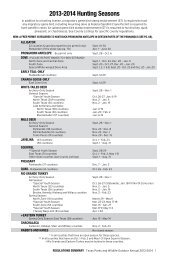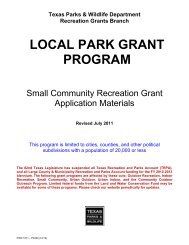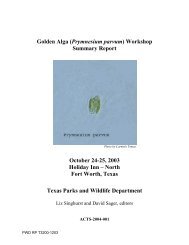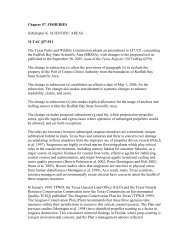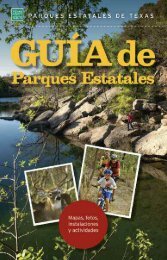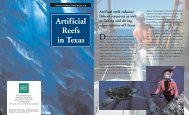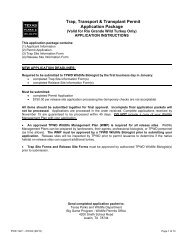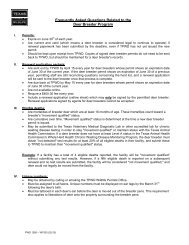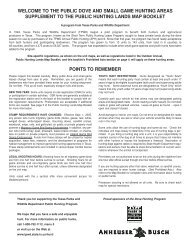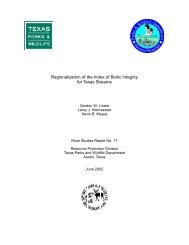1-1 Appendix 1 Responses to survey questions administered to ...
1-1 Appendix 1 Responses to survey questions administered to ...
1-1 Appendix 1 Responses to survey questions administered to ...
Create successful ePaper yourself
Turn your PDF publications into a flip-book with our unique Google optimized e-Paper software.
INLAND ADMINISTRATION--QUESTION 2<br />
RESPONSES: 15<br />
What is the greatest strength/weakness in standardized assessment procedures?<br />
• Strength: Consistent, long-term data sets that show valuable “trends” on<br />
numerous fisheries across the entire state – these have also served us well<br />
politically because all significant lakes are sampled on a regular basis.<br />
• The obvious strength is that data collected in the same manner (<strong>to</strong> the extent<br />
possible) are more likely <strong>to</strong> be directly comparable.<br />
• Greatest strength – the goal of consistent data collection <strong>to</strong> allow comparison of<br />
trends over time.<br />
• Strength – Consistency in data which allows pooling, time series analyses, etc.<br />
• Strength – Ability <strong>to</strong> accumulate comparable data that will lead <strong>to</strong> a better<br />
• understanding of ecosystem relationships.<br />
• Flexibility <strong>to</strong> address new <strong>questions</strong><br />
• Anytime you can develop standard, consistent ways of collecting and analyzing<br />
data that demonstrate sound science, you are better off. That being said, the<br />
agency must be willing <strong>to</strong> constantly revise and revisit those procedures <strong>to</strong> make<br />
sure they conform <strong>to</strong> the most up <strong>to</strong> date and sound methodologies available. The<br />
typical pattern at most agencies is that receptiveness <strong>to</strong> change occurs with a<br />
turnover in staff (e.g., new people, new ideas). A regular pattern of science<br />
review, internally and externally, should be a goal.<br />
• Greatest strength – data is consistently collected and analyzed the same over time<br />
and across water bodies.<br />
• Standard procedures are based on “best information available” and are continually<br />
updated as needed. Procedures are repeatable and therefore suitable for acquiring<br />
trend data and are generally adequate for identifying major problems.<br />
• Strength-Randomized sampling.<br />
• Strength – Standardized sampling eliminates sampling bias.<br />
• Weakness-Adequate funding/manpower.<br />
• The research upon which the program is based has not been formally published,<br />
therefore, it has not received appropriate external evaluation. Sample sizes are<br />
small and confidence intervals are large. Cannot afford <strong>to</strong> increase sample sizes<br />
because of staff/time limitations.<br />
• Weakness: minimum amounts of sampling are usually not enough <strong>to</strong> “statistically<br />
validate” our conclusions. This is because our field staffs are spread <strong>to</strong>o thin and<br />
cannot always afford the time <strong>to</strong> sample as intensively as they might like.<br />
• Greatest weakness – biologists tend <strong>to</strong> perform the minimum statewide<br />
requirement and don’t have <strong>to</strong> “think” about why they are sampling in the first<br />
place.<br />
• Weakness – Cookbook procedures provide <strong>to</strong>o easy an opportunity for staff NOT<br />
<strong>to</strong> think.<br />
2-19



